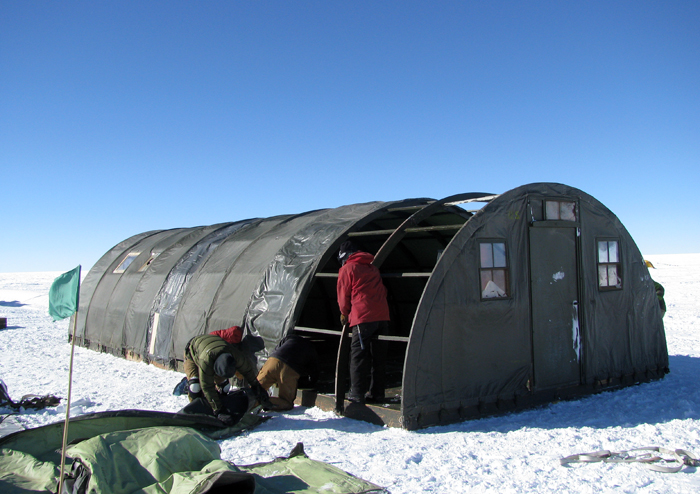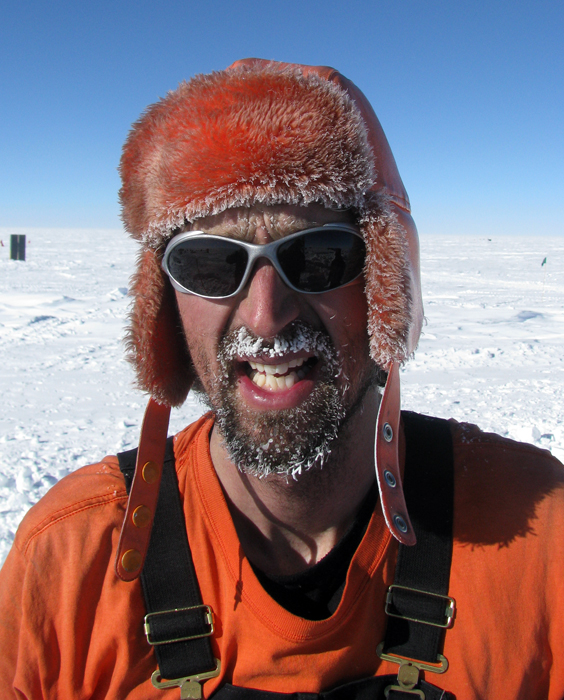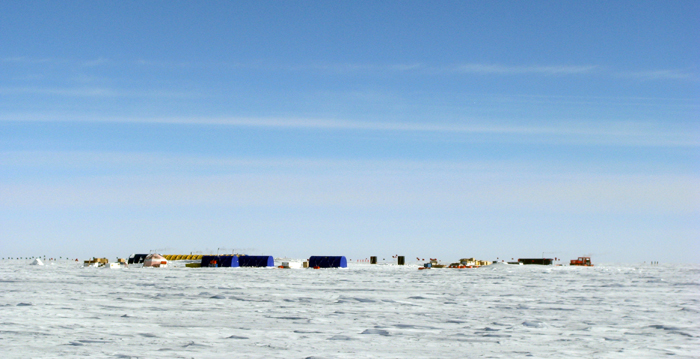|
Prepping for scienceA first-person account of working behind the scenes for Antarctic researchPosted January 23, 2009
Earlier this season, in December, I spent more than three weeks out at Antarctica’s Gamburtsev Province But I’m not a scientist: I’ve worked in the Utility Technician Shop at McMurdo Station More Information
♦ Marine geophysicist Robin Bell led the AGAP South Camp. You can find her blog at Scientific American
♦ Antarctic Sun article: Mountainous Mystery ♦ Profile on Ben Bachelder in the Oct. 29, 2006 issue (page 12) of the Antarctic Sun There were four structures already there: three Polar Havens (16-foot x 20-foot rooms with an arched ceiling) and a 60-foot-long galley structure. I had to get the heat going in all of them, and helped the carpenters put up a couple more structures and dig out the snow that had accumulated behind the existing structures over the winter. We were supposed to be taking it easy while we acclimatized to the high elevation (from 11,000 to 17,000 feet, depending on barometric pressure, which can create huge swings in the physiological altitude), but life-supporting tasks such as gathering snow for meltwater and digging through the food cache were far from leisurely. A few days later the rest of the crew arrived, to make 16 in total, mostly carpenters. Over the course of the next few weeks, we put up nine more structures of various sizes, four 10,000-gallon fuel bladders, oxygen systems for the pilots to sleep with, and a bunch of smaller bits and pieces to make the camp work. One of our more entertaining tasks was sorting through several tons of frozen food and organizing it in a freezer cave that we dug out for the cook. One of our more frustrating tasks was getting the snowmobiles and Tucker Sno-cat fired up each morning, and keeping them running throughout the day. We certainly kept busy, and the weather was crazy, but it was a lot of fun. We had two good storms come through with winds of more than 30 knots, which brought the wind chill down to minus 80 degrees Fahrenheit at its worst. For the most part, though, it’s between minus 30 and minus 40 with 5- to 7-knot winds that bring the temperatures down another 10 to 15 degrees. It appears that there were plenty of storms over the winter, as the snow drifts were much bigger than we expected to see when we got there. Each storm brought more drifting — and more digging. The crew was great; we all got along really well, and that’s of utmost importance in a place as small and restricted as the AGAP South camp. Unfortunately, the stoves, which were my job to set up and maintain, weren’t so pleasant. The high altitude and brutally cold temperatures conspired against me. Sticking valves, freezing lines and vapor lock caused them to act abnormally, and I inevitably was covered in fuel and/or soot troubleshooting them. But that was the worst of it: I didn’t get frostbite or severe hypoxia from the altitude. Out of necessity, we took plenty of warm-up breaks and kept ourselves entertained with cards, dominoes and plenty of board games. And we ate — a lot. Jake, the cook, managed to create glorious meals from the frozen stock of food, but despite our efforts to gorge ourselves thrice a day, we all lost a little weight. Sounds like the ideal diet to some people. With the weather being so unpredictable and needing decent flying conditions at McMurdo Station, AGAP and the South Pole Friday — cancelled. Saturday — cancelled. Sunday — no flight. Monday — cancelled. Tuesday — cancelled … almost. The powers-that-be decided to deliver less cargo so that we could get home without refueling at Pole. So thankfully, I made it back to McMurdo in time for the holidays, but I missed seeing any of the scientists. The day after I left with the rest of the construction crew, the researchers began to arrive. More than three dozen people used the camp in January. The scientists peered through 2½ miles of ice at the least-studied mountain range on the planet. Some flew above in ski-equipped Twin Otters using radar to map the range; others did seismic studies with explosives and strings of geophones to image the mountains like taking an X-ray. It will be interesting to see the images that come back. Surely next season will bring another wave of science, but they won’t need me to help build the camp. Somebody else will light the stoves next year. |



For USAP Participants |
For The Public |
For Researchers and EducatorsContact UsU.S. National Science FoundationOffice of Polar Programs Geosciences Directorate 2415 Eisenhower Avenue, Suite W7100 Alexandria, VA 22314 Sign up for the NSF Office of Polar Programs newsletter and events. Feedback Form |




